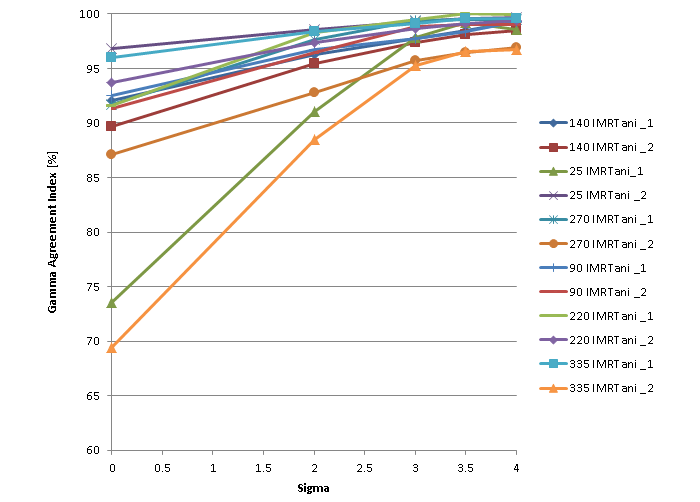Gaussian convolution
Before the analysis is done in EPIQA, measured images may be processed by applying a Gaussian convolution. This "blurs" the EPID images. The degree of blurring is controlled with a Sigma parameter (given in [mm]).
Gaussian convolution is not possible in Varian Portal Dosimetry.
In the following example, the impact of Gaussian convolution shall be demonstrated. An IMRT plan with 6 Gantry angles, 12 fields, beam energy 15MV, was evaluated with EPIQA in the MIX setup (no additional buildup). Eclipse algorithm was AAA 8.6.14 (with our 0.125 cm3 chamber beam data). According to MIX setup, depth of dose matrices in Eclipse was 3 cm.
The Gamma Agreement Index (GAI) in percent gives the fraction of pixels within the evaluation area that pass the Gamma criterion (i.e., where Gamma < 1). Ideally, it is 100%.
The following table shows the GAI for multiple evaluations of the same plan using different degrees of blurring. For the Gaussian convolution, the Sigma setting was varied between zero (no Gaussian convolution) and 4 mm. Each link goes to a screenshot of the respective EPIQA screen:
| Field | No Convolution | Sigma = 2 mm | Sigma = 3 mm | Sigma = 3.5 mm | Sigma = 4 mm |
|---|---|---|---|---|---|
| 140 IMRTani _1 | 92.10% | 96.28% | 97.73% | 98.45% | 99.25% |
| 140 IMRTani _2 | 89.67% | 95.46% | 97.40% | 98.10% | 98.48% |
| 25 IMRTani _1 | 73.59% | 91.07% | 97.79% | 99.21% | 98.59% |
| 25 IMRTani _2 | 96.79% | 98.60% | 99.33% | 99.58% | 99.69% |
| 270 IMRTani _1 | 91.66% | 97.66% | 99.36% | 99.48% | 99.45% |
| 270 IMRTani _2 | 87.15% | 92.80% | 95.76% | 96.46% | 96.91% |
| 90 IMRTani _1 | 92.49% | 96.75% | 97.70% | 98.38% | 99.32% |
| 90 IMRTani _2 | 91.32% | 96.48% | 98.83% | 99.01% | 99.01% |
| 220 IMRTani _1 | 91.60% | 98.32% | 99.47% | 99.99% | 99.96% |
| 220 IMRTani _2 | 93.71% | 97.37% | 98.61% | 99.10% | 99.38% |
| 335 IMRTani _1 | 96.03% | 98.35% | 99.10% | 99.58% | 99.59% |
| 335 IMRTani _2 | 69.43% | 88.46% | 95.29% | 96.59% | 96.76% |
The effect of Gaussian convolution on the GAI is clearer when plotted:

GAI improves with increasing Sigma (=more blurring). Around Sigma = 4 mm, GAI starts to decrease again, because EPID images are blurred more than the Eclipse "images". However, the Sigma value for which the GAI is at maximum is not the same for all fields.
At first glance, Gaussian convolution is a nice tool to improve your results!
Is it "legal" to blur the measured EPID images?
Although Gaussian convolution should not be used unreflectedly (in other words: simply to improve the evaluation results), a point can be made that some blurring may be justified, especially for higher photon energies:
- The EPID is not made of water. The scatter conditions in the sensitive layer of the amorphous silicon imager and in water are different.
- Measurement depth in the EPID is very shallow. Varian states that the water equivalent measurement depth in the aS500 detector is 8 mm. In EPIQA MIX setup, the image measured at this (water equivalent) 8 mm depth is compared (after it has been converted to dose by the GLAaS algorithm) to a dose matrix calculated in dmax depth in water. In EPIQA DMAX setup, the additional buildup on the EPID detector "provides the blurring" by adding some scatter and making the two setups more similar. Therefore, in DMAX setup, less Gaussian blurring (if any) should be necessary to reach the same GAI as in MIX setup.
- The Eclipse beam models and algorithms are far from being perfect. They are still not able to reproduce certain small-scale MLC effects, like inter-leaf leakage of static MLC fields. Eclipse beam modelling still uses a single parameter to describe MLC transmission, which must be therefore specified as an average value. Although in the latest versions of AAA the tongue and groove effect is included for dynamic MLC fields, the calculation grid of clinical plans is typically still around 2.5 mm. The situation has improved with modern 64bit workstations (24 GB RAM on a typical T5500). It is now possible to calculate a AAA plan with 1 mm grid, assuming 3 locally calculated fields. But with one dose point every 2.5 mm, small-scale patterns simply cannot be resolved. The aS500 on the other hand has a resolution of 400 mm / 512 px = 0.7813 mm per pixel in the imager plane. Gaussian blurring "resamples" the high resolution measured image (the aS1000 even has 1024 x 512 px) down to the level of the coarser "calculated image". This clearly improves agreement. Therefore, the degree of Gaussian blurring also depends on the calculation gris setting. However, since Eclipse matrices are exported at a fixed resolution of 1.25 x 1.25 mm, there is no point in calculating at a finer grid!
- With Gaussian convolution, the effect of random inter-fractional setup-variations may be simulated. Due to small variations of setup, internal organ motion and elastic deformations of the body (which is not rigid like a phantom), a certain small-scale fluence pattern (e.g., the underdosage strip of the tongue and groove effect, the overdosage strip of interleaf leakage etc.) will not always hit the same spot (= cell). These variations appear on different time scales: intra-fractional and inter-fractional. Due to the variations, a fluence pattern which contains high spatial frequencies will be smeared out to some extent. It is fair to assume that the smearing, if it is random, can be described by a gaussian distribution.